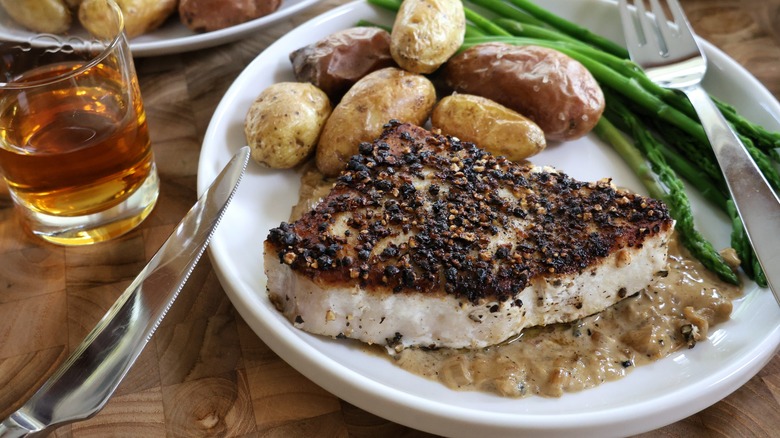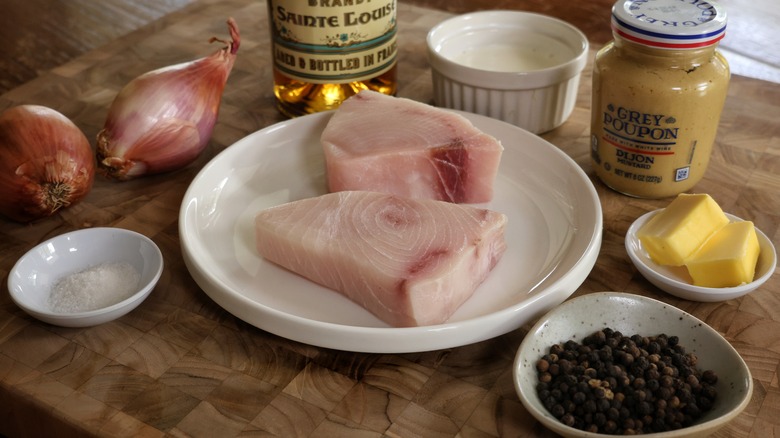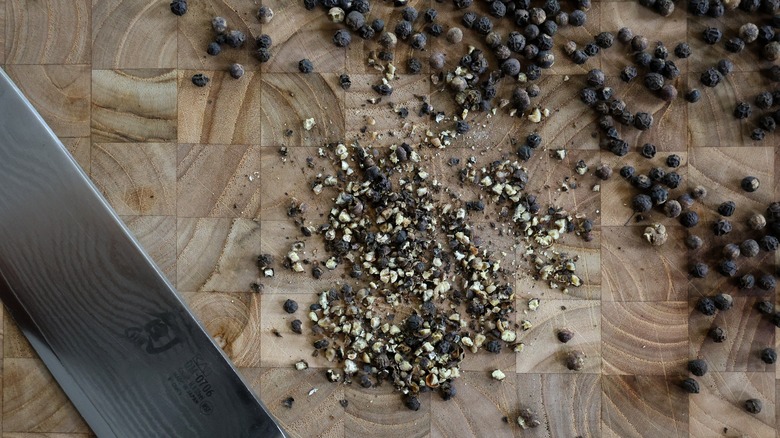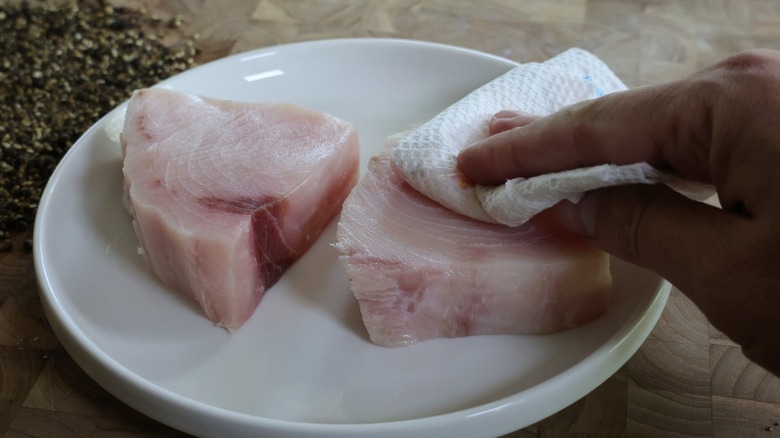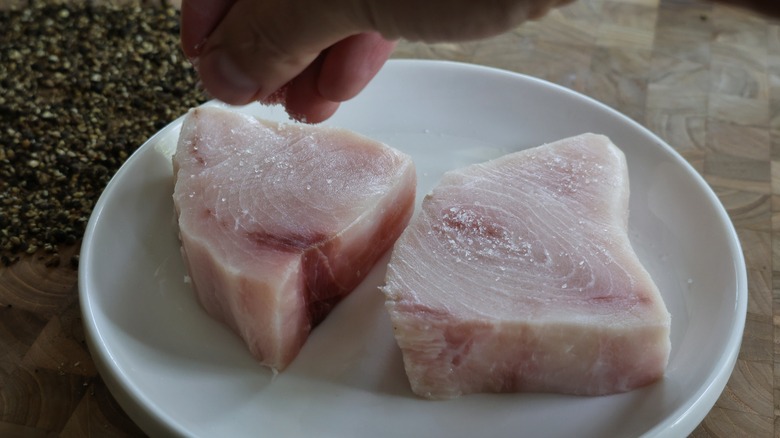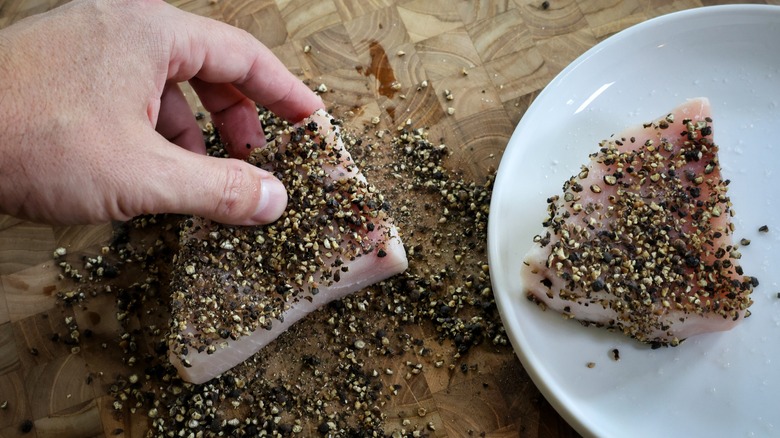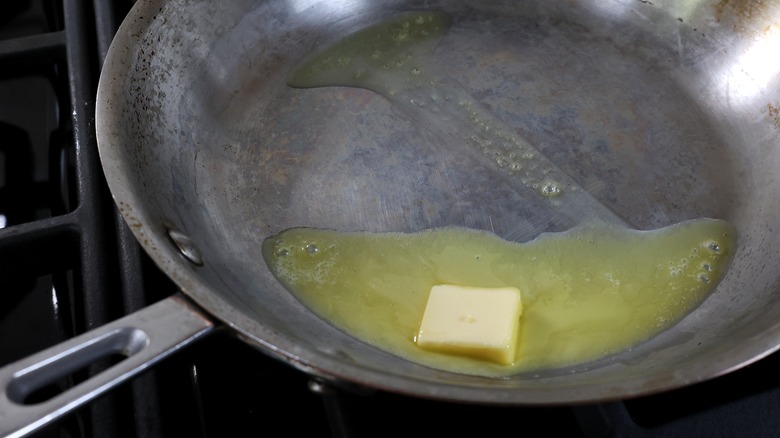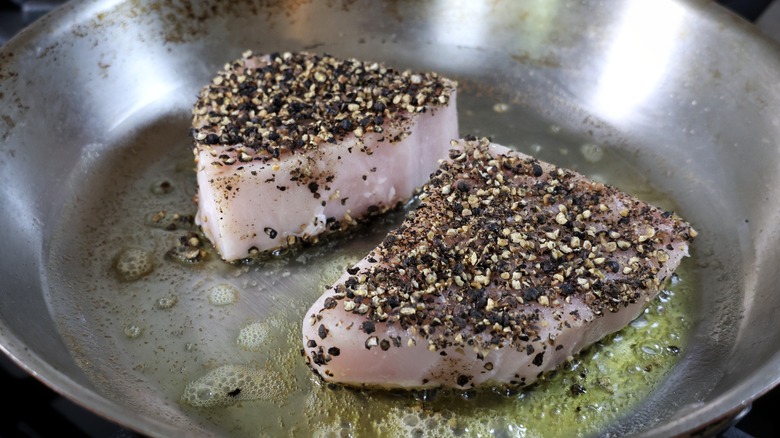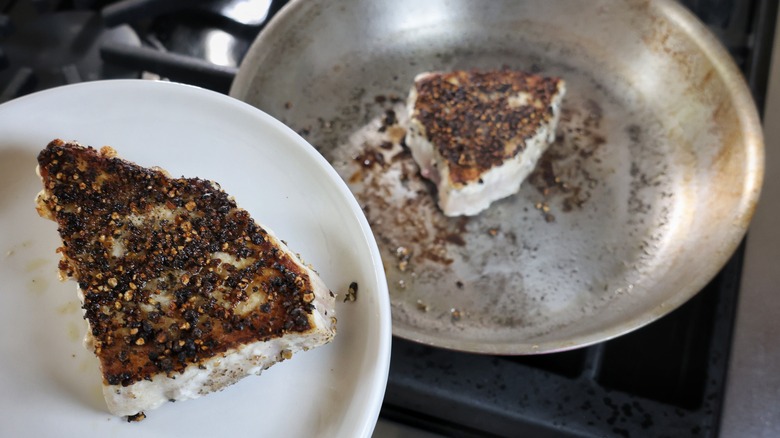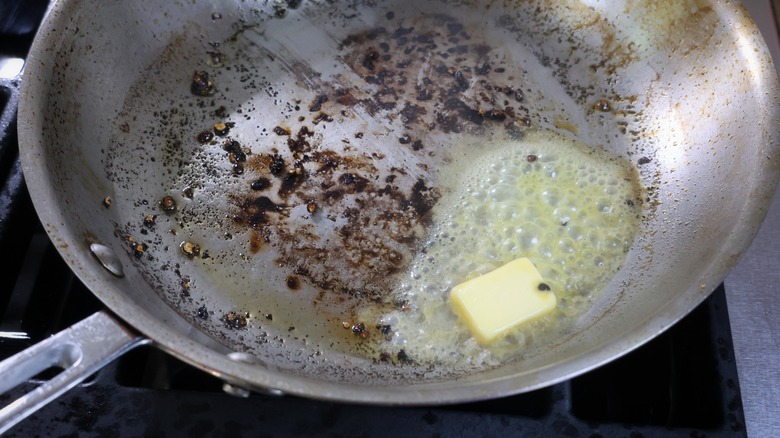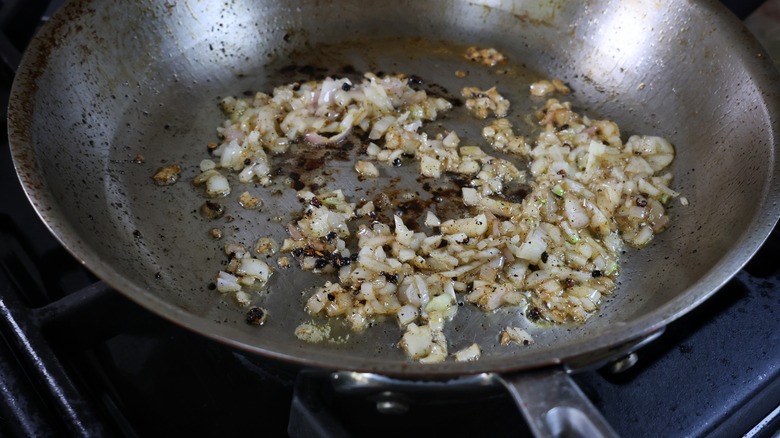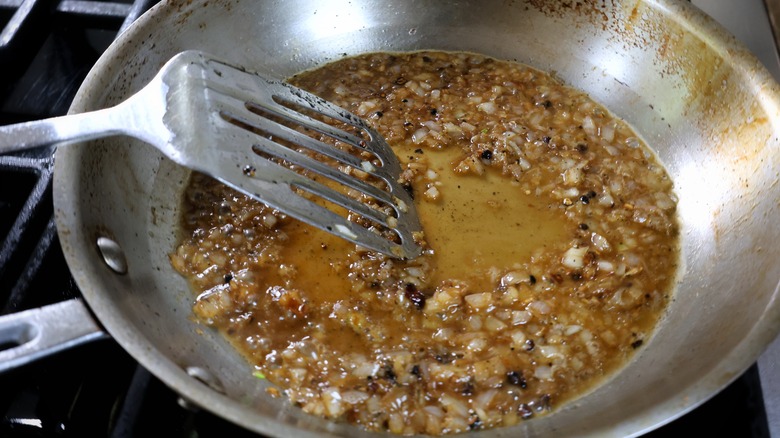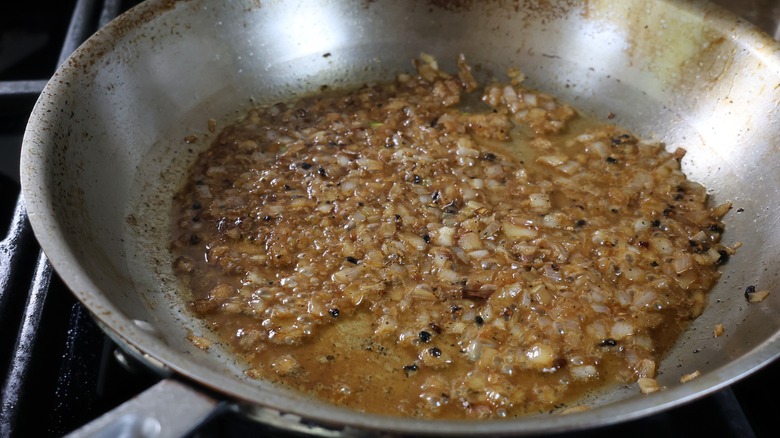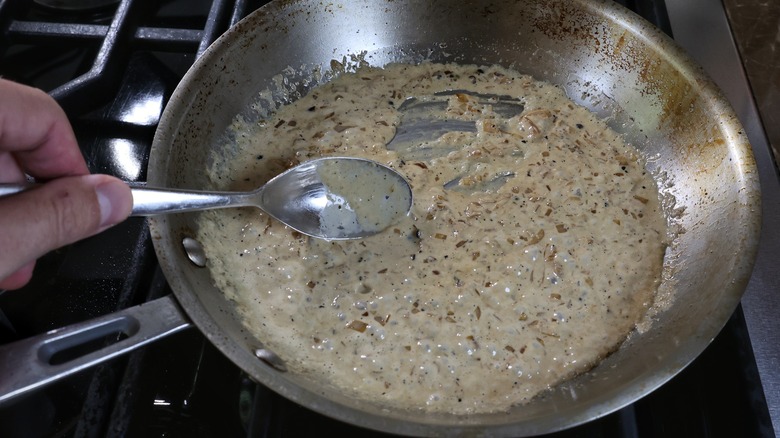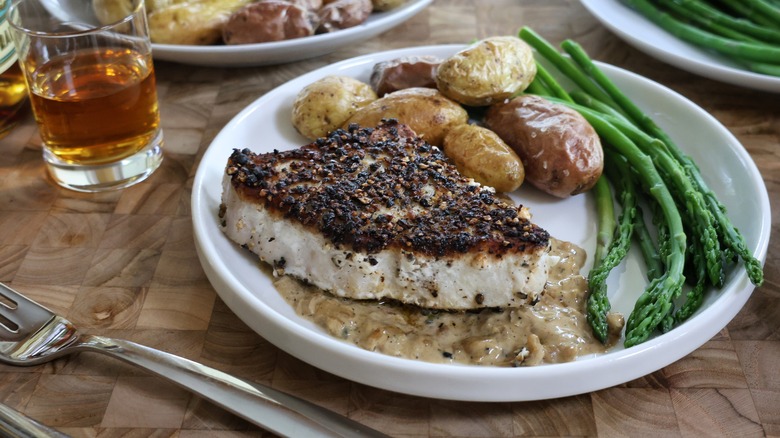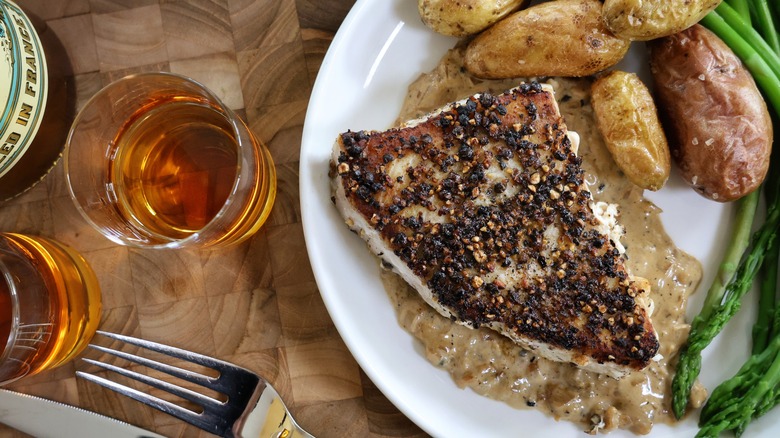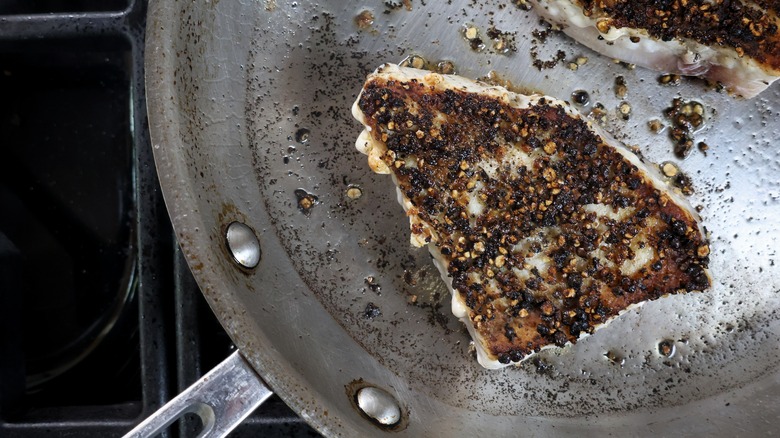Buttery Swordfish Au Poivre Recipe
Steak au poivre is a classic French dish featuring a seared piece of beef that's coated in coarse black pepper. While the steak is resting, you make a pan sauce by deglazing the pan with cognac or brandy, scraping up the fond and black pepper, simmering aromatic shallots in the liquor, and then finishing the sauce with Dijon mustard and cream. It is rich and decadent, and the pepper crust and brandy cream sauce provide vibrant counterpoints to the rich beef.
In this recipe, we turn that traditional dish on its head and replace the beef with a tender swordfish steak. Swordfish is a dense, meaty fish that holds up well to the au poivre preparation. Using swordfish in place of beef not only results in a wonderfully fork-tender finished dish, but the delicate flavor of the fish allows the rest of the dish to really sing. The pungent, zingy peppercorn crust and the sweet, aromatic brandy sauce combine with the mild flavor of the swordfish to create a meal that may just surpass its traditional steak forebear.
Steak au poivre is an absolute classic and has stood the test of time, but this swordfish au poivre is a fantastic next iteration. You certainly won't regret trading in beef for the bounty of the sea.
Gather the swordfish au poivre ingredients
For this recipe, you will need a pair of swordfish steaks, black peppercorns, butter, shallots, brandy or cognac, Dijon mustard, cream, and salt. Once you have these ingredients together, you are ready to start cooking.
Step 1: Crush the peppercorns
Using the side of a knife or a mortar and pestle, crush the peppercorns to a very coarse texture.
Step 2: Pat the swordfish dry
Pat the swordfish steaks dry with a paper towel.
Step 3: Salt the fish
Salt the swordfish evenly on both sides.
Step 4: Coat the swordfish
Spread the pepper out on a plate or cutting board and press the swordfish into it to form a thick coat on each side.
Step 5: Heat the skillet
Bring a heavy-bottomed skillet to medium heat and add 1 tablespoon butter.
Step 6: Sear
Place the swordfish steaks in the pan and cook for 3–4 minutes on each side, until cooked through.
Step 7: Rest
Remove the swordfish to a plate to rest.
Step 8: Start the sauce
Reduce the heat to medium-low and add the remaining butter to the skillet.
Step 9: Cook the shallots
Add the shallots and cook for 1–2 minutes, until the shallots are softened and fragrant.
Step 10: Deglaze the pan
Pour the brandy into the pan and scrape any fond from the bottom.
Step 11: Reduce the sauce
Reduce the brandy for 1 minute.
Step 12: Finish the sauce
Add the mustard, cream, and any juice from the resting swordfish plate and cook, stirring often, for 1–2 minutes, until the sauce is emulsified. Remove from the heat.
Step 13: Plate and serve
Plate the swordfish steaks on top of a bed of sauce, and serve immediately.
Buttery Swordfish au Poivre Recipe
A riff on French steak au poivre, this recipe swaps the beef for a meaty swordfish steak and retains all of the buttery, creamy goodness of the original.
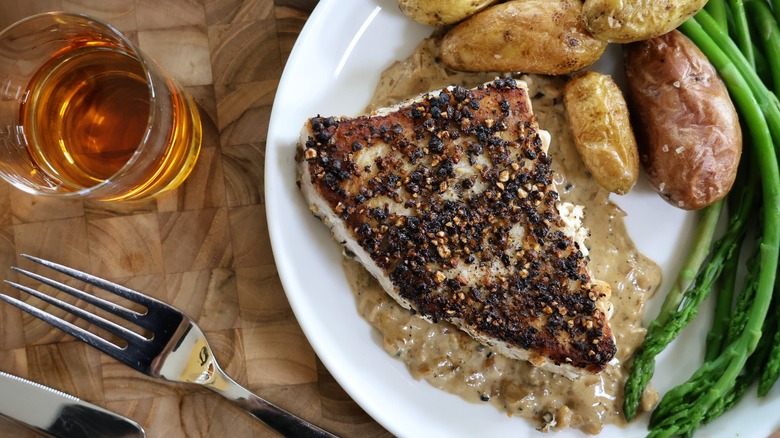
Ingredients
- 2 tablespoons black peppercorns
- 2 (6-ounce) swordfish steaks
- ½ teaspoon salt
- 2 tablespoons salted butter, divided
- ¼ cup finely diced shallot
- ¼ cup brandy or cognac
- ½ teaspoon Dijon mustard
- ¼ cup heavy cream
Directions
- Using the side of a knife or a mortar and pestle, crush the peppercorns to a very coarse texture.
- Pat the swordfish steaks dry with a paper towel.
- Salt the swordfish evenly on both sides.
- Spread the pepper out on a plate or cutting board and press the swordfish into it to form a thick coat on each side.
- Bring a heavy-bottomed skillet to medium heat and add 1 tablespoon butter.
- Place the swordfish steaks in the pan and cook for 3–4 minutes on each side, until cooked through.
- Remove the swordfish to a plate to rest.
- Reduce the heat to medium-low and add the remaining butter to the skillet.
- Add the shallots and cook for 1–2 minutes, until the shallots are softened and fragrant.
- Pour the brandy into the pan and scrape any fond from the bottom.
- Reduce the brandy for 1 minute.
- Add the mustard, cream, and any juice from the resting swordfish plate and cook, stirring often, for 1–2 minutes, until the sauce is emulsified. Remove from the heat.
- Plate the swordfish steaks on top of a bed of sauce, and serve immediately.
Nutrition
| Calories per Serving | 545 |
| Total Fat | 33.9 g |
| Saturated Fat | 17.0 g |
| Trans Fat | 0.9 g |
| Cholesterol | 176.4 mg |
| Total Carbohydrates | 8.7 g |
| Dietary Fiber | 2.4 g |
| Total Sugars | 2.5 g |
| Sodium | 628.3 mg |
| Protein | 35.7 g |
What is the difference between brandy and cognac?
Brandy and cognac are often used interchangeably, as in this recipe, but they are not the same thing. They are often quite similar, but there are important differences to keep in mind when choosing a brandy or cognac.
For starters, cognac is a subset of brandy. Just like Champagne or tequila, cognac is a regionally-specific product. In order to be called cognac, it must be produced in the Cognac region of France (just as proper Champagne must come from the Champagne region of France, and tequila must come from one of five Mexican states). But, that isn't the only characteristic that separates cognac from other brandies. Cognac must also be made from fermented grapes, which are distilled and then aged in oak barrels. While this is common practice for many varieties of brandy, it is not true for all brandies.
Brandy is actually a very wide term used for any distilled fruit alcohol. The majority of brandies are made using grapes, and any product labeled only as brandy will certainly be a distilled grape liquor. However, there are many other types of fruit brandies, such as kirschwasser and calvados, which are made from cherries and apples, respectively.
For this recipe, we suggest sticking with a grape-derived brandy or cognac to create the traditional au poivre flavor, but when it comes to the wider world of libations, there are many wonderful brandies to explore.
How can I change up this fish au poivre recipe?
In this recipe, we chose to use a nice swordfish steak for a relatively traditional take on an au poivre dish. While this recipe is exquisite, we always encourage tailoring the food you cook to your palate, so here are some ways that you can make this recipe your own.
First, change up the protein. We chose swordfish for its meaty texture and delicate flavor. The pepper crust and au poivre sauce beautifully complement the swordfish, but this is not the only fish that works here. If you aren't a fan of swordfish, try substituting another dense, meaty fish. A few good options are ahi tuna, halibut, mahi-mahi, and even salmon. You want to avoid anything too flaky, as it might not hold up in the pan.
Another great place to adjust things is in your choice of brandy. There are a wide variety of brandies and cognacs out there, each with their own unique flavor profile. Some brandies are quite sweet and have aromas like vanilla, while others offer only a subtle sweetness and more fruity notes. The brandy imparts a lot of flavor to the au poivre sauce, so picking one that you like to drink on its own will result in a superior finished dish.
